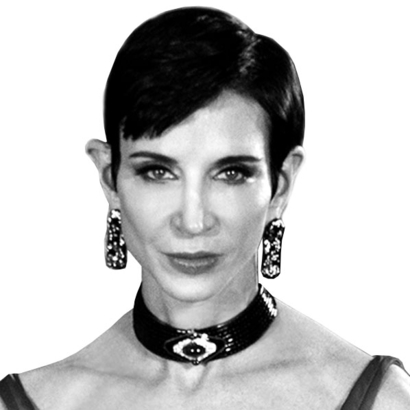In one of his frequent, touching pronouncements about women, Yves Saint Laurent declared, “The most beautiful clothes that can dress a woman are the arms of the man she loves. But for those who haven’t had the fortune of finding this happiness, I am there.”
With this generous statement, Yves demonstrated how astutely he understood the intimate relationship between women and their wardrobes, fabric and female skin, and the states of being dressed and undressed. In Freudian terms, he recognized that luxurious clothing could be a displacement—that is to say, a surrogate—for love.
Because he adored us, Yves never deformed, caricatured, or hobbled the female physique. Nor did he have an aversion to our anatomy, as his Lalanne breastplates from 1969, his sheer chiffon dress of 1968, and his risqué plumed costumes for Zizi Jeanmaire make clear. When Yves said, “Nothing is more beautiful than a naked body,” he was not just referring to men.
In addition to endowing us with beauty, he bestowed upon us (as he himself said) the additional gifts of confidence and power. His “smoking,” which he believed to be “for a woman, an indispensable garment,” is perhaps his most enduring manifesto for appropriating these attributes of the patriarchy.
In contrast with a painter such as Edward Burne-Jones, whose work Yves collected, or a couturier like Paul Poiret, whose wife, Denise, was his inspiration, Yves had a vision of femininity too complex to be confined to a single ideal. He required multiple female archetypes, each one reflecting a facet of his own self-image. His first, of course, was his mother, the soignée Lucienne, who, like others to follow, was an indulgent facilitator and protector of his creativity.
With her strong jawline and preternaturally long, trouser-sheathed legs, Betty Catroux was the garçonne, a mirror of Yves’s own elegant androgyny. Artistic, erratic, and adventurous like Yves, Loulou de la Falaise was a colorful projection of his playful bohemian spirit. From childhood onward, Yves was captivated by the performing arts, and so he adulated such terpsichorean goddesses as Jeanmaire, Margot Fonteyn, and Maya Plisetskaya. “Being dressed by Yves,” the great Russian ballerina said, “makes one discover oneself.”
The incarnation of America, a country he adored (and which returned his embrace), was Nan Kempner—famously anointed by Diana Vreeland as the nation’s “only chic woman.” Nearer to him was Jacqueline de Ribes, the kind of rarefied Parisienne about whom Yves dreamed as a youth in Oran.
The exquisite vicomtesse, who began collaborating with the designer while he was still at Dior, was for Yves an “ivory unicorn” and “a royal blue orchid.” Always a voracious reader (and an occasional writer himself), Yves found his intellectual avatar in Marguerite Yourcenar, the first woman elected to the Académie Française. For this formidable woman of letters, he invented a velvet, passementerie-trimmed academician’s robe, as stately as it was seductive.
There were so many other women—Catherine Deneuve, Danielle Mitterrand, Marie-Hélène de Rothschild—populating Yves’s universe. But in no way can I situate myself among them. My own encounters with Yves were either posthumous (I spent a week, for a Vanity Fair story, immersed in Yves’s Rue de Babylone apartment, before its dismantling, in 2008) or mediated entirely through his business-and-life partner, Pierre Bergé.
There were so many women—Catherine Deneuve, Danielle Mitterrand, Marie-Hélène de Rothschild—populating Yves’s universe.
As Geoffrey Beene’s muse, I was tacitly forbidden to wear any other designer’s clothes, or even to cultivate alliances with his professional counterparts. Though I did not find these circumstances oppressive, they became more trying from a sartorial standpoint during the last months of my pregnancy. And so, in a small act of disloyalty, I bought a Rive Gauche by Yves Saint Laurent floral smock dress and wore it one Sunday afternoon to an exhibition of Old Master drawings at Sotheby’s.
On my way out, as I was descending the staircase, I encountered Mr. Beene, on his way in. The sight of him made me freeze in place. He appraised me slowly up and down, and then—uncharacteristically—he decided to ignore my transgression. In retrospect, the day I wore that YSL dress was a critical moment in my own life as a woman. Not only had I loosened my mentor’s grip on me; due to my condition, I also had a figure temporarily amplified by a full bust and rounded hips. Just weeks away from giving birth, I was doubly female because I was carrying a baby girl.
So my repertoire of YSL clothing has been quite limited, to say the least. I have two YSL fourrure hats and a couture bracelet and necklace by Loulou, all given to me years ago by her mother, Maxime (I still wear everything), and a few other YSL items I’ve collected along the way. Yet Yves’s charming words of gratitude to women are so all-encompassing, I feel like they could even apply to me: “I want to thank all the women who have worn my clothes, the famous and the unknown, who have been so faithful to me and given me so much joy.”

Amy Fine Collins is an Editor at Large for AIR MAIL. She is the author of The International Best-Dressed List: The Official Story













